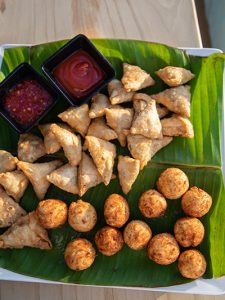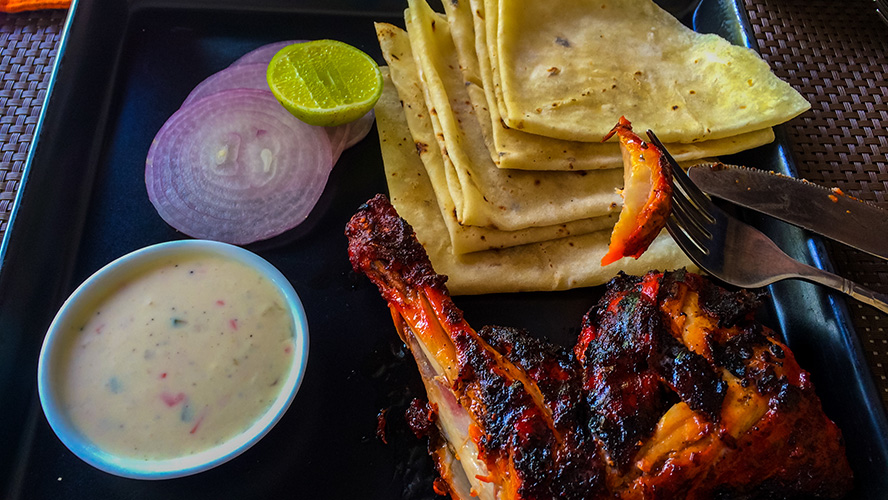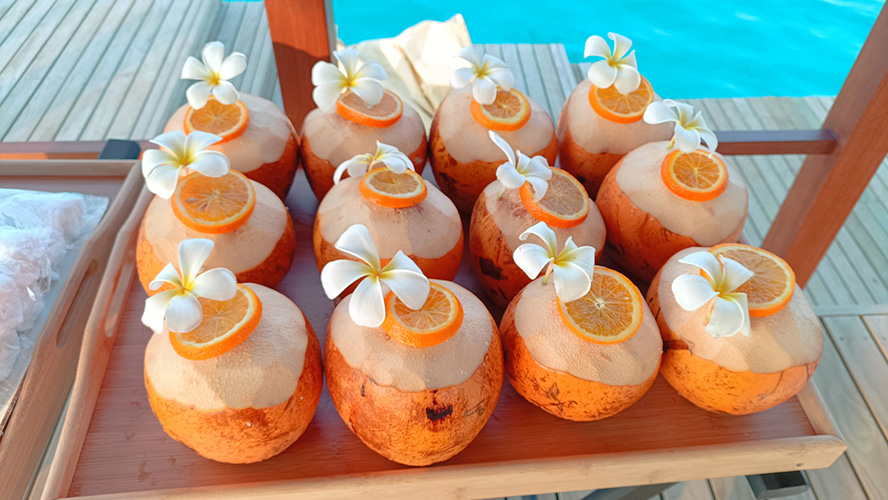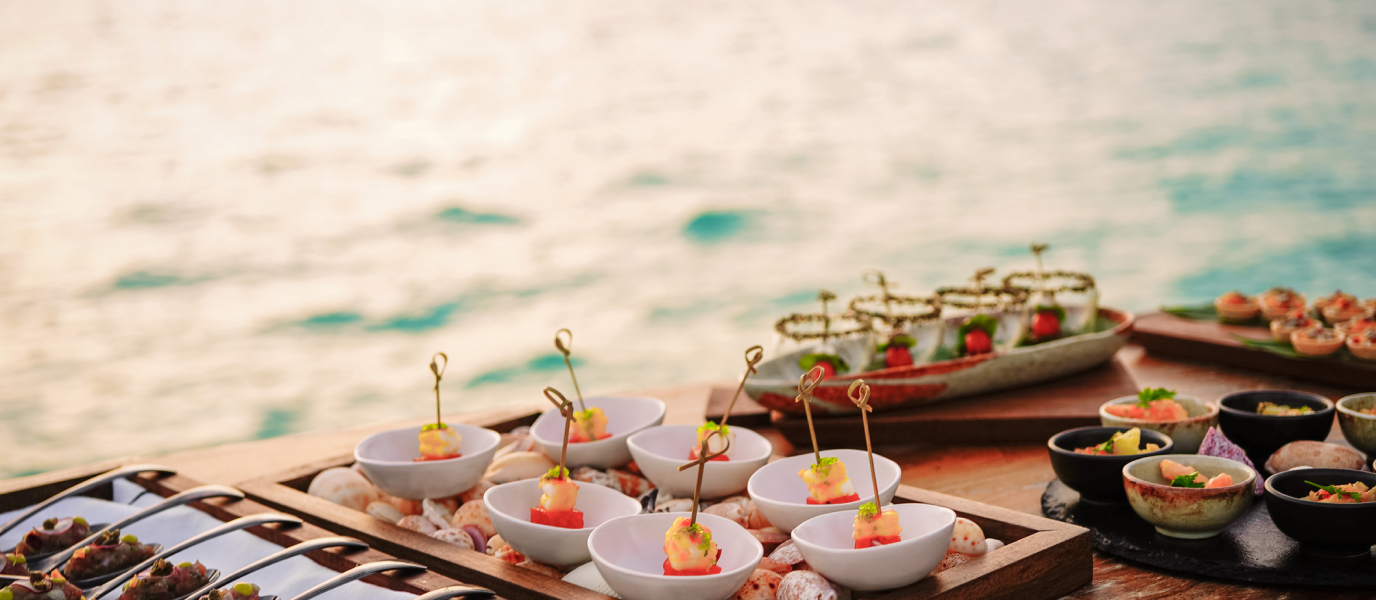It’s easy to understand why the sea plays a starring role in local food in the Maldives. The country is completely surrounded by the Indian Ocean, which washes along the channels between the various atolls, and fishing is the main way its inhabitants obtain their food. Among the many delights of the ocean, tuna is the star guest at this culinary feast.
Coconut comes a close second and, in the Maldives, people use its milk, water and oil, and chop and grate the flesh as if it were a vegetable. It adds a characteristic flavour and a hearty consistency to the dishes and sauces of typical Maldivian food.
Interestingly, in each atoll, and sometimes on each island, the ingredients used in local dishes are prepared in different ways. These localisms give each dish a subtly different flavour, and they’re almost always served with the country’s most popular salad: mashuni, made from tuna, coconut, onion, lime, and chilli.
Where to try local food in the Maldives
Thanks to its unique geographical layout and a lack of large towns, the best way for foreign visitors to try local Maldivian food is at their hotel. Many resorts and hotels have restaurants that specialise in the national cuisine and the food of neighbouring countries.
Even hotel menus that mainly feature international cuisine normally give a nod to the occasional Maldivian dish too.
In Malé (link to URL), the capital, you’ll also find restaurants (link to URL) that specialise in Maldivian food. However, it’s important to note that this is one of the few places in the country where a relationship exists between the local population and its overseas visitors. Restaurants in the city where you can sample Maldivian flavours include Symphony, Café de Male and Secret Recipe. These restaurants also serve dishes from other Asian countries, and the rest of the world too.
Gulha

The Maldivian version of the international croquette are little balls called gulha. They always contain tuna, which normally comes from a tin. The fish is wrapped in dough made from wheat or rice flour, egg, grated coconut, onion, ginger, curry, turmeric, and a few drops of lemon juice. The dough is shaped into balls and fried in plenty of oil before being served as an aperitif or starter.
Bajiya
f gulha are reminiscent of croquettes, the triangular bajiya is like an empanadilla, although they’re actually a local version of the famous and extremely delicious Indian samosa. They were originally an aperitif that was typically eaten at celebrations such as weddings and birthdays, but they can now be found everywhere.
The main difference from a typical samosa is that they’re stuffed with dried or tinned fish, curry, onion and, sometimes a bit of chilli. They’re occasionally stuffed with chicken, and when they are, the chef differentiates them from fish bajiya by adding a red ingredient to the pastry.
Kulhiborkinaa
Local Maldivian food has many of its own delicious and tempting dishes like kulhi borkinaa, a type of fish cake. It typically includes smoked tuna and little pieces of coconut, onion and rice that are added to the flour and egg mixture.
Each chef adds a personal touch to their cake mixture by including their own choice of spices, so you experience new flavours each time you try it.
Curry dishes
Curry is one of the defining dishes of local food in the Maldives. Turmeric, garlic, ginger, coriander, cumin, and chilli, among other spices, are combined to make an oily and highly aromatic sauce called riha, and it’s made in many different ways depending on where it’s cooked and by whom.

It’s used to season fish and chicken dishes, which are normally served with rice or rosji, the Maldivian version of the Indian chapati, an unleavened flatbread.
Sweet Maldivian dishes
Plenty of sweet dishes features in local Maldivian food and each is tastier than the next. Huno hakuru folhi is a cake made from flour, coconut, and sugar, while bodibaiy is a dessert made from rice and lots of sugar. Boakiba is a coconut and rice cake that is baked and usually served with almonds or other nuts.
The most irresistible cake in the Maldives is definitely aluvi boakibba. It’s made from coconut, coconut milk, yucca flour, egg and sugar, plus other ingredients, and is usually eaten at special celebrations.
Typical drinks
It’s important to remember that the Maldives is a strictly Muslim country when it comes to alcoholic drinks. That means they aren’t widely available and can only be ordered in specific places where they’re permitted, for example, on resort-islands or on boat trips to the different atolls.
Instead, the national drink is tea, which is drunk at any time and for any reason. Coconut is also an important part of the national diet, including coconut milk (kaashi kuri) and water, two of the most common drinks. Similarly, tropical fruit juice is also popular, but it’s normally expensive as it has to be imported.

Another drink that’s typical to the Maldives is raa, which is made from palm juice or sugar cane juice. It’s sometimes left to ferment so that becomes alcoholic, while other times its simply left as vegetable juice.
Restaurants at Hotel Barceló Whale Lagoon Maldives
This recently opened 5-star hotel is in South Ari Atoll and guests will enjoy a varied and highly recommendable dining experience at its restaurants.
Sea Salt, the resort’s flagship restaurant, is the perfect choice for dinner and buffet-style dinners where you can watch your food being freshly prepared before your very eyes.
Aqua specialises in seafood and its dishes are a wonderful fusion of Mediterranean and Asian cuisine.
Meanwhile, Breeze is a pool-side restaurant and bar that serves snacks, aperitifs, and sandwiches, and is also a great spot for a sunset drink or cocktail. Finally, guests will love Magical, a beach club with a lounge zone that serves cocktails and aperitifs.







































































